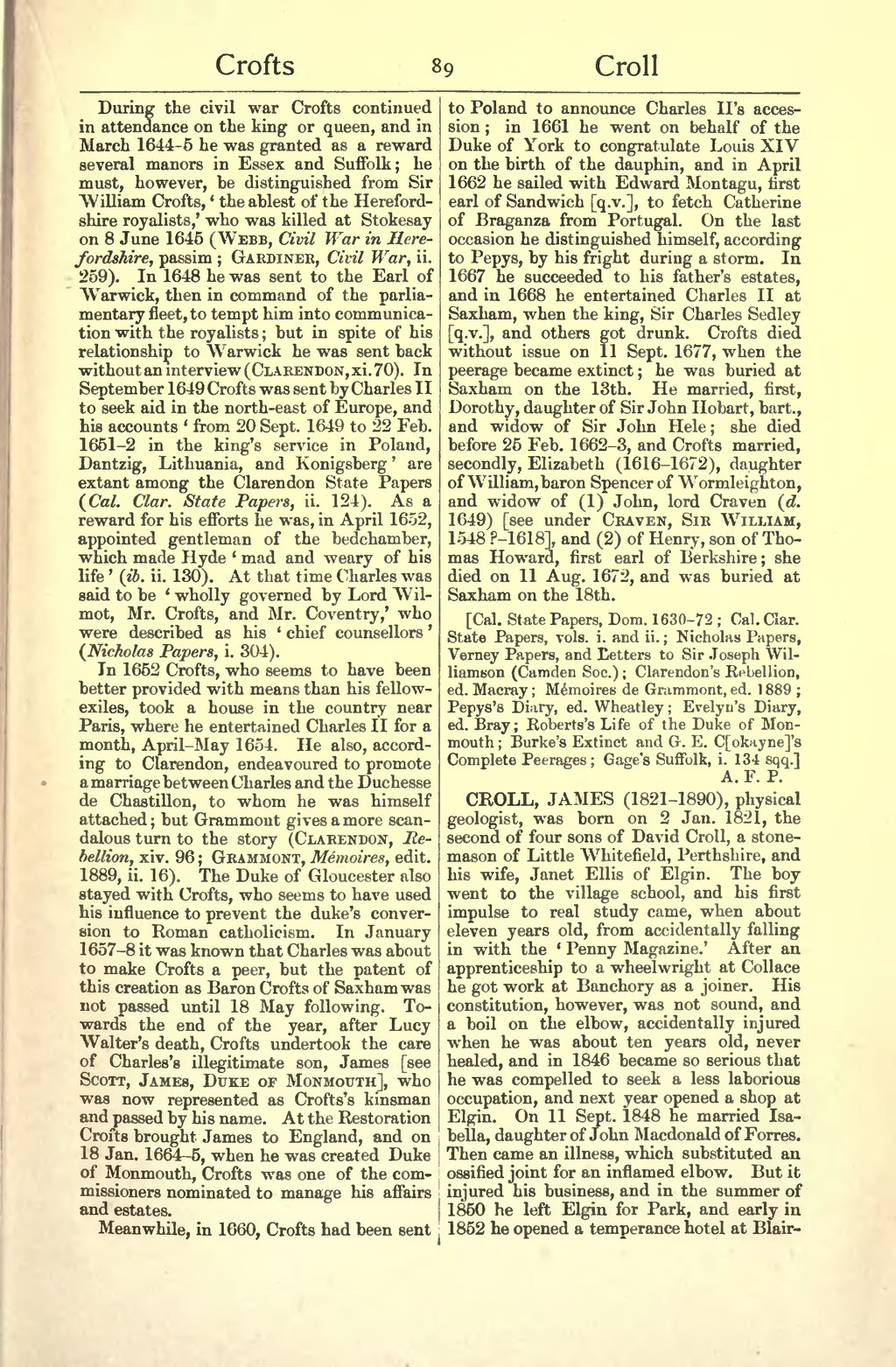During the civil war Crofts continued in attendance on the king or queen, and in March 1644-5 he was granted as a reward several manors in Essex and Suffolk; he must, however, be distinguished from Sir William Crofts, 'the ablest of the Hereford- shire royalists,' who was killed at Stokesay on 8 June 1645 (Webb, Civil War in Herefordshire, passim; Gardiner, Civil War, ii. 259). In 1648 he was sent to the Earl of Warwick, then in command of the parliamentary fleet, to tempt him into communication with the royalists; but in spite of his relationship to Warwick he was sent back without an interview (Clarendon, xi. 70). In September 1649 Crofts was sent by Charles II to seek aid in the north-east of Europe, and his accounts ' from 20 Sept. 1649 to 22 Feb. 1651-2 in the king's service in Poland, Dantzig, Lithuania, and Konigsberg ' are extant among the Clarendon State Papers (Cal. Clar. State Papers, ii. 124). As a reward for his efforts he was, in April 1652, appointed gentleman of the bedchamber, which made Hyde 'mad and weary of his life' (ib. ii. 130). At that time Charles was said to be 'wholly governed by Lord Wilmot, Mr. Crofts, and Mr. Coventry,' who were described as his 'chief counsellors ' {Nicholas Papers, i. 304).
In 1652 Crofts, who seems to have been better provided with means than his fellow-exiles, took a house in the country near Paris, where he entertained Charles II for a month, April-May 1654. He also, according to Clarendon, endeavoured to promote a marriage between Charles and the Duchesse de Chastillon, to whom he was himself attached; but Grammont gives a more scandalous turn to the story (Clarendon, Rebellion, xiv. 96; Grammont, Memoires, edit. 1889, ii. 16). The Duke of Gloucester also stayed with Crofts, who seems to have used his influence to prevent the duke's conversion to Roman Catholicism. In January 1657-8 it was known that Charles was about to make Crofts a peer, but the patent of this creation as Baron Crofts of Saxhamwas not passed until 18 May following. Towards the end of the year, after Lucy Walter's death, Crofts undertook the care of Charles's illegitimate son, James [see Scott, James, Duke of Monmouth], who was now represented as Crofts's kinsman and passed by his name. At the Restoration Crofts brought James to England, and on 18 Jan. 1664-5, when he was created Duke of Monmouth, Crofts was one of the commissioners nominated to manage his affairs and estates.
Meanwhile, in 1660, Crofts had been sent to Poland to announce Charles II's accession; in 1661 he went on behalf of the Duke of York to congratulate Louis XIV on the birth of the dauphin, and in April 1662 he sailed with Edward Montagu, first earl of Sandwich [q. v.], to fetch Catherine of Braganza from Portugal. On the last occasion he distinguished himself, according to Pepys, by his fright during a storm. In 1667 he succeeded to his father's estates, and in 1668 he entertained Charles II at Saxham, when the king, Sir Charles Sedley [q.v.], and others got drunk. Crofts died without issue on 11 Sept. 1677, when the peerage became extinct; he was buried at Saxham on the 13th. He married, first, Dorothy, daughter of Sir John Hobart, bart., and widow of Sir John Hele; she died before 25 Feb. 1662-3, and Crofts married, secondly, Elizabeth (1616-1672), daughter of William, baron Spencer of Wormleighton, and widow of (1) John, lord Craven (d. 1649) [see under Craven, Sir William, 1548 ?-1618], and (2) of Henry, son of Thomas Howard, first earl of Berkshire; she died on 11 Aug. 1672, and was buried at Saxham on the 18th.
[Cal. State Papers, Dora. 1630-72; Cal. Clar. State Papers, vols. i. and ii.; Nicholas Papers, Verney Papers, and Letters to Sir Joseph Williamson (Camden Soc.); Clarendon's Rebellion, ed. Macray; Memoires de Grammont, ed. 1889; Pepys's Diary, ed. Wheatley; Evelyn's Diary, ed. Bray; Roberta's Life of the Duke of Monmouth; Burke's Extinct and Or. E. C[okayne]'s Complete Peerages; Gage's Suffolk, i. 134 sqq.]
CROLL, JAMES (1821–1890), physical geologist, was born on 2 Jan. 1821, the second of four sons of David Croll, a stone-mason of Little Whitefield, Perthshire, and his wife, Janet Ellis of Elgin. The boy went to the village school, and his first impulse to real study came, when about eleven years old, from accidentally falling in with the 'Penny Magazine.' After an apprenticeship to a wheelwright at Collace he got work at Banchory as a joiner. His constitution, however, was not sound, and a boil on the elbow, accidentally injured when he was about ten years old, never healed, and in 1846 became so serious that he was compelled to seek a less laborious occupation, and next year opened a shop at Elgin. On 11 Sept. 1848 he married Isabella, daughter of John Macdonald of Forres. Then came an illness, which substituted an ossified joint for an inflamed elbow. But it injured his business, and in the summer of 1850 he left Elgin for Park, and early in 1852 he opened a temperance hotel at Blair-
